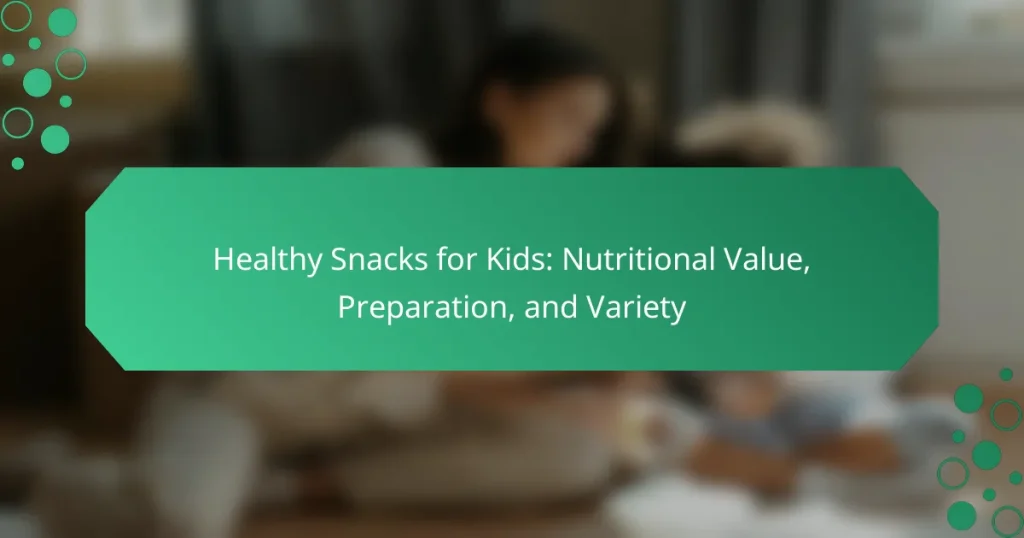Nurturing healthy eating habits in children is vital for their growth and development. By fostering a supportive environment and making nutritious choices a family priority, parents can instill lifelong wellness practices. A balanced meal plan that includes a variety of food groups ensures kids receive essential nutrients for optimal health and cognitive function.
How Can Parents Promote Healthy Eating Habits for Kids?
Parents can promote healthy eating habits for kids by creating a supportive environment that encourages nutritious choices. This involves integrating healthy foods into daily routines and making meals a family affair.
Encouraging family meals
Family meals provide an opportunity for children to experience healthy eating in a social setting. Aim for at least five family meals per week, where everyone shares their day and enjoys nutritious foods together. This practice not only fosters communication but also reinforces the importance of balanced nutrition.
Involving kids in meal prep
Involving kids in meal preparation can make them more interested in what they eat. Allow children to help with simple tasks like washing vegetables or stirring ingredients. This hands-on experience can empower them to make healthier choices and develop cooking skills.
Setting a positive example
Children often mimic the behaviors of their parents, so setting a positive example is crucial. When parents choose healthy foods and demonstrate balanced eating habits, kids are more likely to follow suit. Share your enthusiasm for fruits, vegetables, and whole grains to inspire similar preferences in your children.
Offering a variety of foods
Providing a wide range of foods helps children develop a taste for different flavors and textures. Introduce new fruits and vegetables regularly, and encourage kids to try at least one new food each week. This variety can prevent mealtime boredom and promote a more balanced diet.
Establishing regular meal times
Regular meal times help create a routine that can improve children's eating habits. Aim to have meals at the same times each day to regulate hunger and promote healthy snacking. Consistency can also help children understand when to expect food, reducing the likelihood of impulsive eating.
What Nutrients Are Essential for Children's Growth?
Essential nutrients for children's growth include vitamins, minerals, proteins, healthy fats, and carbohydrates. Each of these components plays a crucial role in supporting physical development, cognitive function, and overall health.
Vitamins and minerals
Vitamins and minerals are vital for various bodily functions, including immune support and bone health. Key vitamins such as A, C, D, and E, along with minerals like calcium and iron, should be included in a child's diet.
Fruits, vegetables, dairy products, and whole grains are excellent sources of these nutrients. Aim for a colorful plate to ensure a wide range of vitamins and minerals are consumed daily.
Proteins for development
Proteins are essential for growth, tissue repair, and muscle development in children. Sources of protein include lean meats, fish, eggs, dairy, legumes, and nuts.
Children should consume a variety of protein sources to meet their needs, typically around 1.1 to 1.5 grams of protein per kilogram of body weight daily. This can be achieved by incorporating protein-rich foods into meals and snacks.
Healthy fats for brain health
Healthy fats are crucial for brain development and function in children. Omega-3 and omega-6 fatty acids, found in fish, avocados, nuts, and seeds, are particularly important.
Encourage the inclusion of these healthy fats in meals, aiming for sources like fatty fish twice a week and using olive oil or avocado in cooking. This supports cognitive development and overall health.
Carbohydrates for energy
Carbohydrates are the primary source of energy for children, fueling their active lifestyles. Whole grains, fruits, and vegetables provide complex carbohydrates that are beneficial for sustained energy levels.
Limit refined sugars and processed carbs, which can lead to energy spikes and crashes. Aim for a balanced intake of carbohydrates, making sure at least half of the grains consumed are whole grains for optimal health.
How to Create a Balanced Meal Plan for Kids?
Creating a balanced meal plan for kids involves incorporating a variety of food groups to ensure they receive essential nutrients. Focus on including fruits, vegetables, whole grains, and lean proteins while limiting processed foods to promote overall health and wellness.
Incorporating fruits and vegetables
Fruits and vegetables are vital for children's growth and development, providing essential vitamins, minerals, and fiber. Aim for at least five servings of fruits and vegetables each day, mixing colors and types to maximize nutrient intake.
Encourage kids to try different fruits and vegetables by making them fun and accessible. For example, create colorful fruit salads, smoothies, or vegetable sticks with dips. Involve children in selecting and preparing these foods to increase their interest.
Including whole grains
Whole grains are an important source of energy and nutrients, including fiber, which aids digestion. Choose whole grain options like brown rice, whole wheat bread, and oatmeal over refined grains to provide sustained energy and support healthy growth.
When planning meals, aim for at least half of the grains served to be whole grains. A simple way to incorporate them is by substituting white rice with quinoa or using whole grain pasta in favorite dishes.
Choosing lean proteins
Lean proteins are crucial for muscle development and overall health in children. Incorporate sources such as chicken, turkey, fish, beans, and legumes into their meals to provide the necessary protein without excess fat.
Consider serving protein-rich snacks like yogurt or hummus with whole grain crackers. This not only helps meet protein needs but also keeps kids satisfied between meals.
Limiting processed foods
Processed foods often contain high levels of sugar, salt, and unhealthy fats, which can negatively impact children's health. Strive to limit these foods and instead focus on whole, minimally processed options.
Read labels carefully to identify hidden sugars and additives. A practical tip is to prepare meals at home using fresh ingredients, which can help avoid the pitfalls of processed foods while also teaching kids valuable cooking skills.
What Are the Common Challenges in Kids' Nutrition?
Kids' nutrition often faces several challenges that can hinder the development of healthy eating habits. Common issues include picky eating, easy access to unhealthy snacks, and busy family schedules that complicate meal preparation.
Picky eating habits
Picky eating is a prevalent issue among children, where they may refuse to try new foods or prefer a limited selection. This behavior can lead to nutritional deficiencies if not addressed properly.
To encourage a more varied diet, parents can introduce new foods gradually and pair them with familiar favorites. Making meals visually appealing and involving kids in the cooking process can also increase their willingness to try different foods.
Access to unhealthy snacks
Children often have easy access to unhealthy snacks, which can undermine healthy eating habits. Items like sugary treats, chips, and soda are not only appealing but also widely available in homes and schools.
To combat this, parents should stock healthy snacks such as fruits, vegetables, and whole grains. Creating a designated snack time and discussing the importance of nutrition can help children make better choices.
Busy schedules affecting meal prep
Busy family schedules can significantly impact meal preparation, leading to reliance on fast food or convenience meals that are often less nutritious. Time constraints can make it challenging to cook healthy meals from scratch.
To manage this, families can plan meals ahead of time, utilize batch cooking, and prepare simple recipes that require minimal time. Keeping a well-stocked pantry with healthy staples can also facilitate quicker meal options during hectic days.
How Can Schools Support Healthy Eating?
Schools play a crucial role in promoting healthy eating habits among children by integrating nutrition into their daily routines. By providing nutritious meals, implementing educational programs, and fostering a supportive environment, schools can significantly influence students' dietary choices.
Implementing nutrition education
Nutrition education in schools helps children understand the importance of healthy eating and how it affects their growth and development. Programs can include classroom lessons, interactive activities, and hands-on cooking demonstrations to engage students effectively.
To implement effective nutrition education, schools should align their curriculum with national dietary guidelines and local health standards. For example, incorporating lessons on reading food labels, understanding portion sizes, and recognizing healthy food options can empower children to make informed choices.
Schools can also collaborate with local health organizations to provide resources and training for teachers. Regular workshops and seminars can keep educators updated on the latest nutrition research and teaching strategies, ensuring that students receive accurate and relevant information.






